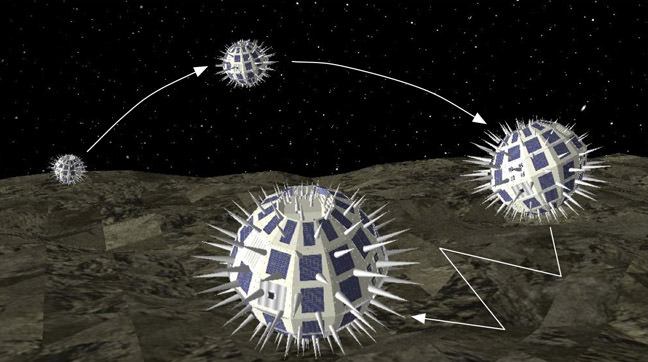[/caption]
With all there’s yet to learn about our solar system from the many smaller worlds that reside within it — asteroids, protoplanets and small moons — one researcher from Stanford University is suggesting we unleash a swarm of rover/spacecraft hybrids that can explore en masse.
Marco Pavone, an assistant professor of aeronautics and astronautics at Stanford University and research affiliate at JPL, has been developing a concept under NASA’s Innovative Advanced Concepts (NIAC) Program that would see small spherical robots deployed to small worlds, such as Mars’ moons Phobos and Deimos, where they would take advantage of low gravity to explore — literally — in leaps and bounds.
Due to the proposed low costs of such a mission, multiple spacecraft could be scattered across a world, increasing the area that could be covered as well as allowing for varied surfaces to be explored. Also, were one spacecraft to fail the entire mission wouldn’t be compromised.
The concept is similar to what NASA has done in the past with the Mars rovers, except multiplied in the number of spacecraft (and reduced in cost.)
The robots would be deployed from a “mother” spacecraft and spring into action upon landing, tumbling, hopping and vaulting their way across low-mass worlds.
In addition to providing our first views from the surfaces of such worlds, Pavone’s hybrid rovers could also help prepare for future, more in-depth exploration.
“The systematic exploration of small bodies would help unravel the origin of the solar system and its early evolution, as well as assess their astrobiological relevance,” Pavone explains. “In addition, we can evaluate the resource potential of small bodies in view of future human missions beyond Earth.”
Read more from NASA’s Office of the Chief Technologist here.
Photo courtesy of Marco Pavone


These types of systems are more likely to be feasible in the near future than some of the exuberant ideas about building the Enterprise. They are also low risk and low cost.
LC
my neighbor’s step-aunt makes $82/hr on the laptop. She has been unemployed for ten months but last month her pay was $19756 just working on the laptop for a few hours. Here’s the site to read more ?????? http://hirebestfreelancer.blogspot.com
UT has of late been getting a lot of spam of this nature. Posting filters need to be put in place.
LC
Yes, but diligence by you, me, and the rest, and a very quick-to-respond moderating team removes them very quickly.
Personally, I prefer this system over one that requires a Captcha-type input for every post.
my co-worker’s sister makes $77 an hour on the computer. She has been out of a job for 9 months but last month her pay check was $21877 just working on the computer for a few hours. Read more on this web site ?????? http://Makecash11.blogspot.com
Spammer Please Flag !!!!Spammer Please Flag !!!!dsfsdfadsfSpammer Please Flag !!!!Spammer Please Flag !!!!Spammer Please Flag !!!!Spammer Please Flag !!!!Spammer Please Flag !!!!Spammer Please Flag !!!!Spammer Please Flag !!!!Spammer Please Flag !!!!Spammer Please Flag !!!!Spammer Please Flag !!!!Spammer Please Flag !!!!Spammer Please Flag !!!!Spammer Please Flag !!!!
Replies like this are just as bad.
These types of systems are more likely to be feasible in the near future than some of the exuberant ideas about building the Enterprise. They are also low risk and low cost.
LC
More sci-fi coming to fruition!
http://tiny.cc/4l9cew
More sci-fi coming to fruition!
http://tiny.cc/4l9cew
How big is one? What are the scientific properties? Gonna be somewhat low angle photography unless taken on the fly! And as far as I can tell, we still can’t get anything conclusive from this type of machine. Mars has as many questions now as it did before we landed rovers. Only the questions become more specific…are the fossilized microbes really evidence of past life? Why does martian soil give off methane when encouraged? Are gullies that look water formed, actually formed by water? I have proposed a similar project myself, but methinks one of the properties necessary is to be able to look at dust/rock/exudations/ice/microbial evidence…and send those pics back to earth such that we are getting a first hand look. Found ice? Maybe, maybe not…but warm it within the probe and watch it melt…pretty conclusive! Warm it further, watch it boil. Now we KNOW what we’re dealing with. Then a spectral analyses of the vapour will give us the components but I just don’t see the point if all we’re going to get is tantalyzing hints.
How big is one? What are the scientific properties? Gonna be somewhat low angle photography unless taken on the fly! And as far as I can tell, we still can’t get anything conclusive from this type of machine. Mars has as many questions now as it did before we landed rovers. Only the questions become more specific…are the fossilized microbes really evidence of past life? Why does martian soil give off methane when encouraged? Are gullies that look water formed, actually formed by water? I have proposed a similar project myself, but methinks one of the properties necessary is to be able to look at dust/rock/exudations/ice/microbial evidence…and send those pics back to earth such that we are getting a first hand look. Found ice? Maybe, maybe not…but warm it within the probe and watch it melt…pretty conclusive! Warm it further, watch it boil. Now we KNOW what we’re dealing with. Then a spectral analyses of the vapour will give us the components but I just don’t see the point if all we’re going to get is tantalyzing hints.